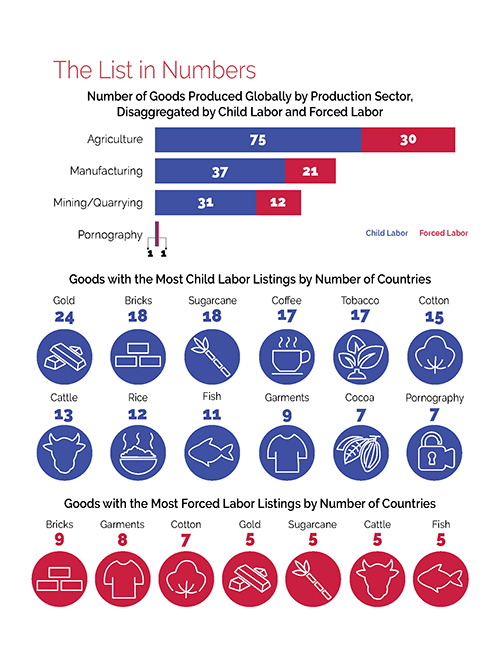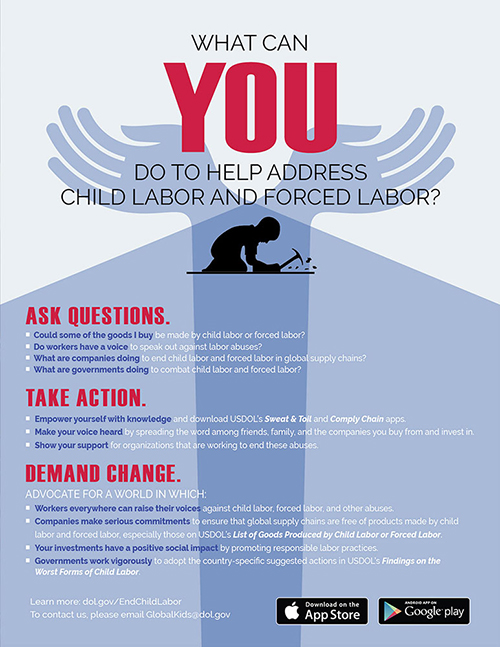List of Goods Produced by Child Labor or Forced Labor
The Bureau of International Labor Affairs (ILAB) maintains a list of goods and their source countries which it has reason to believe are produced by child labor or forced labor in violation of international standards, as required under the Trafficking Victims Protection Reauthorization Act (TVPRA) of 2005 and subsequent reauthorizations. The List of Goods Produced by Child Labor or Forced Labor comprises 159 goods from 78 countries and areas, as of September 28, 2022.
ILAB maintains the List primarily to raise public awareness about forced labor and child labor around the world and to promote efforts to combat them; it is not intended to be punitive, but rather to serve as a catalyst for more strategic and focused coordination and collaboration among those working to address these problems.
Publication of the List has resulted in new opportunities for ILAB to engage with foreign governments to combat forced labor and child labor. It is also a valuable resource for researchers, advocacy organizations and companies wishing to carry out risk assessments and engage in due diligence on labor rights in their supply chains.
The countries on the List span every region of the world. The most common agricultural goods listed are sugarcane, cotton, coffee, tobacco, cattle, rice, and fish. In the manufacturing sector, bricks, garments, textiles, footwear, carpets, and fireworks appear most frequently. In mined or quarried goods, gold, coal and diamonds are most common.
ILAB published the initial TVPRA List in 2009 and updated it annually through 2014, following a set of procedural guidelines that were the product of an intensive public consultation process. ILAB now updates and publishes the List every other year, pursuant to changes in the law.
Procedural Guidelines
On January 25, 2024, ILAB's Office of Child Labor, Forced Labor, and Human Trafficking published Procedural Guidelines for the development and maintenance of the List of Goods from countries produced by child labor or forced labor in violation of international standards.
| Country/Area | Good Sort ascending | Exploitation Type |
|---|---|---|
| Nepal | There are reports that children as young as age five are forced to quarry stones in Nepal. An NGO report and the media indicate that these children work as bonded laborers, often working alongside their parents and other family members in quarries and riverbeds across the country. Families borrow money and are paid too little to escape their debt, remaining in debt bondage. Some children, usually with their families, live at the worksite where they are watched by guards and forbidden from leaving. The children are often forced to perform hazardous work, including carrying heavy loads. Employers threaten to withhold food from the workers, including children. Some children experience physical violence by their employers. |
Child Labor, Forced Labor |
| Uganda | There are reports that children as young as age 7 work in stone quarries in Uganda. Children, primarily boys, quarry and break stone in 3 of the 4 regions of Uganda. Areas of particular concern for children working in quarries include the northeastern Karamoja region and Central Uganda. The Uganda Bureau of Statistics estimates that 2,124 workers are involved in formal employment in stone quarrying; the majority of these work in quarries in Central Uganda. However, many workers are also known to quarry stone in informal, artisanal quarries, including many children. According to international organizations, media sources, and the U.S. Department of State, numerous incidents of children quarrying and breaking stone have been reported across the country and most notably in the northeastern Karamoja region. This work prevents children from attending school. In addition, children are exposed to loud noises, dust, long hours in extreme heat, and injury from flying stone fragments. Accidents from quarrying stone have resulted in loss of limbs, broken spinal cords, and loss of sight. |
Child Labor |
| Zambia | Child Labor | |
| China | ILAB has reason to believe that multiple solar products produced in China are made with an input using forced labor, specifically from polysilicon produced in China. These products include photovoltaic ingots and wafers (China), solar cells (China), and solar modules (China). Polysilicon was added to ILAB’s List of Goods Produced by Child Labor or Forced Labor in 2021 for forced labor. Forty-five percent of the world’s solar-grade polysilicon and more than half of China’s polysilicon is produced in the Xinjiang Uyghur Autonomous Region, where research has shown it is produced under conditions of forced labor. China has 98 percent of the world's manufacturing capacity for photovoltaic ingots; 97 percent for photovoltaic wafers; 81 percent for solar cells; and 77 percent for solar modules, all of which are made with polysilicon. Many of the largest global producers of photovoltaic ingots and wafers, solar cells, and solar modules directly source polysilicon from entities believed to use forced labor in its production. In 2020, solar cells and modules imported from China accounted for over $24 billion. While the U.S. directly imported about 5 percent of its solar cells and modules from China, it is likely that additional solar cells and modules made with polysilicon produced with forced labor enter the U.S. through other countries. Many solar companies operating around the world have suppliers based in China and many are owned by Chinese companies. Over 42 percent of global imports of solar cells and modules come from China. This research suggests that other downstream products of polysilicon, such as semiconductors, silica-based goods, and solar generators, may be produced with an input produced with forced labor. |
Inputs Produced with Forced Labor |
| China | ILAB has reason to believe that multiple solar products produced in China are made with an input using forced labor, specifically from polysilicon produced in China. These products include photovoltaic ingots and wafers (China), solar cells (China), and solar modules (China). Polysilicon was added to ILAB’s List of Goods Produced by Child Labor or Forced Labor in 2021 for forced labor. Forty-five percent of the world’s solar-grade polysilicon and more than half of China’s polysilicon is produced in the Xinjiang Uyghur Autonomous Region, where research has shown it is produced under conditions of forced labor. China has 98 percent of the world's manufacturing capacity for photovoltaic ingots; 97 percent for photovoltaic wafers; 81 percent for solar cells; and 77 percent for solar modules, all of which are made with polysilicon. Many of the largest global producers of photovoltaic ingots and wafers, solar cells, and solar modules directly source polysilicon from entities believed to use forced labor in its production. In 2020, solar cells and modules imported from China accounted for over $24 billion. While the U.S. directly imported about 5 percent of its solar cells and modules from China, it is likely that additional solar cells and modules made with polysilicon produced with forced labor enter the U.S. through other countries. Many solar companies operating around the world have suppliers based in China and many are owned by Chinese companies. Over 42 percent of global imports of solar cells and modules come from China. This research suggests that other downstream products of polysilicon, such as semiconductors, silica-based goods, and solar generators, may be produced with an input produced with forced labor. |
Inputs Produced with Forced Labor |
| India | Child Labor | |
| Bangladesh | Child Labor | |
| Brazil | Child Labor | |
| Kenya | Child Labor | |
| Tanzania | Child Labor |
your hand? Download ILAB's Sweat & Toil App today!
Are you a company looking to fight child labor and forced labor in supply
chains?





